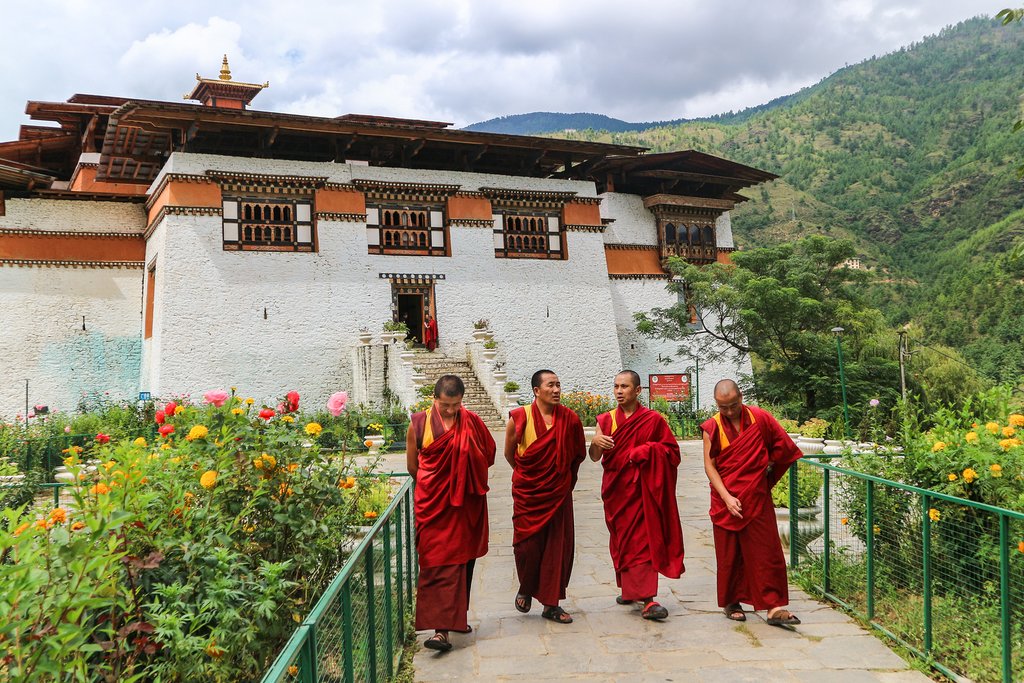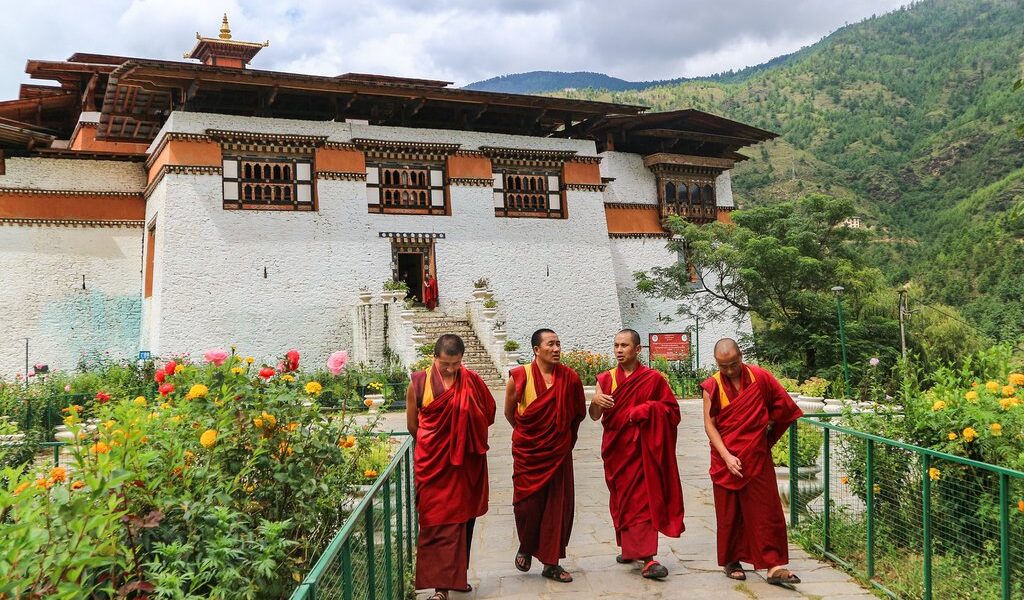
May is late spring in Bhutan, but increasing humidity foreshadows the impending monsoon and restricts mountain views. Temperatures are generally warm though, so this can be a nice time to enjoy cultural sightseeing. Here are a few important things to know about travel to Bhutan in May.
The month of May in Bhutan presents a fascinating confluence of seasonal transitions, straddling the line between the tail end of the pleasant spring and the approaching wet monsoon. This unique positioning results in weather patterns that exhibit characteristics of both seasons, creating a diverse experience for travelers. Temperatures across the country are generally warm, although they can become uncomfortably hot, especially at lower elevations. As May progresses, humidity levels tend to increase, adding to the warmth. The air can also become quite dusty during this period.
One potential drawback of visiting Bhutan during late spring is that the stunning mountain views, which are a major draw for many tourists, can sometimes be obscured by rain clouds and increased humidity as the monsoon season draws nearer. Therefore, visitors should be prepared for the possibility of limited visibility. It’s advisable to pack an umbrella or raincoat, particularly if you plan to travel later in the month, as the likelihood of encountering rain increases.
It’s important to remember that altitude plays a significant role in shaping the weather conditions across Bhutan. The southern regions of the country, which border India, have a subtropical climate. As a result, these areas can experience very high temperatures in May. In fact, most travelers may find these regions uncomfortably hot during this time of year. The town of **Gelephu**, situated near the renowned **Royal Manas National Park**, serves as a prime example. This town experiences average temperatures ranging from 72 to 90° F (22 to 32° C) in May, and temperatures frequently climb even higher than that.
Moving towards the mid-hills of Bhutan, the weather conditions become more agreeable. In **Punakha**, which sits at an elevation of 4250 feet (1300 meters), the average temperature during May ranges from 63 to 81° F (17 to 27° C). This range is generally considered to be quite comfortable for most people. The capital city, **Thimphu**, is located at a higher altitude of 7200 feet (2200 meters), and it experiences cooler temperatures throughout the year. In May, temperatures in Thimphu typically range from 55 to 73° F (13 to 23° C). Whether these temperatures are ideal for you will depend on your personal preferences, but it’s unlikely that you’ll encounter scorching heat in the higher elevations of Bhutan during May.
Bhutan’s peak tourism season falls in March and April when the weather is considered optimal. However, May sees a slight decrease in tourist numbers, primarily because the weather is not as consistently pleasant as in the preceding months. While you’re unlikely to encounter large crowds at most attractions, it’s still recommended that you book your tours and accommodations well in advance, particularly if you have specific preferences regarding where you’d like to stay. Planning ahead ensures that you secure your desired choices and avoid any potential disappointments.
For those with ample time and resources, venturing into central and eastern Bhutan is highly recommended. These more remote regions remain largely accessible in May, especially during the earlier part of the month, before the monsoon rains intensify and potentially disrupt overland travel and cause flight cancellations. The **Bumthang Valley**, often referred to as a collection of valleys, is located in central Bhutan and is widely regarded as the cultural and religious heartland of the country. Exploring this valley offers a deep dive into Bhutanese traditions and spirituality. **Eastern Bhutan**, on the other hand, is significantly less developed than the western part of the country. Reaching this area might necessitate taking small-plane flights, but the reward is an experience far from the well-trodden tourist paths. In eastern Bhutan, you’re unlikely to encounter many, if any, other tourists, providing a truly authentic and immersive experience.
If your time is limited and you’re primarily interested in seeing Bhutan’s iconic sights, focusing on **Western Bhutan** is a practical approach. The cities of Thimphu and **Paro**, as well as the scenic Punakha Valley and **Wangdue**, are key destinations in this region. A visit to the famous **Tiger’s Nest Monastery** is almost always included on Bhutan itineraries. These locations are popular for good reason, showcasing the country’s rich cultural heritage and stunning landscapes.
Even with the approaching monsoon, trekking conditions in May are still generally acceptable, although it’s essential to pack waterproof gear as a precaution. Be prepared for the possibility of cloud cover and humidity obscuring mountain views in certain areas.
Despite these potential limitations, May presents a compelling opportunity for trekking because camping overnight at higher altitudes won’t be as frigid as during other times of the year. Whether you’re an experienced and seasoned trekker or a novice eager to explore Bhutan’s natural beauty on foot, there are numerous options to choose from. The challenging **Snowman Trek** and the moderately challenging **Jomolhari Trek** offer exhilarating adventures for those seeking a demanding physical experience. Alternatively, you can opt for gentler day hikes through picturesque rural landscapes and charming communities, allowing you to return to comfortable and beautiful hotels each night.
On the first day of the fourth lunar month, a unique and captivating event takes place: a procession of monks. All the monks residing in Punakha embark on a journey to their summer residence in Thimphu, which is situated at a higher and cooler altitude. This procession is a significant religious event, and people line the route to receive blessings from the monks. Witnessing this event provides a fascinating glimpse into Bhutanese religious practices.
For those considering a trip to Bhutan in May, there are various itineraries to explore, each offering a unique perspective on the country’s diverse offerings.
The **Dagala Thousand Lakes Trek – 12 Days** itinerary allows you to marvel at the awe-inspiring views of **Everest**, Jomolhari, **Masang Gang**, and numerous other majestic mountains. This six-day trek is skillfully combined with cultural sightseeing experiences, providing a well-rounded exploration of Bhutan.
The **Nature and Culture in Bhutan – 10 Days** itinerary offers a blend of natural beauty and cultural immersion. From the iconic Tiger’s Nest Monastery to the tranquil streets of Paro, this tour allows you to appreciate the simple pleasures of Bhutan’s pristine landscapes and its distinctly preserved culture.
For those seeking a more adventurous experience, the **Jomolhari Round Trek and Cultural Tour – 17 Days** itinerary is an excellent choice. This itinerary seamlessly combines a wild adventure with an exploration of Bhutan’s unique culture. The trek itself is challenging, but the rewards are immense, making it one of Bhutan’s most unforgettable experiences.
B-161

